The Deloro site cleanup project
Information on the cleanup at the Deloro site in the Municipality of Marmora and Lake.
Location
The Village of Deloro has a population of 139 and is located 65 kilometres east of Peterborough. The village sits next to a 202-hectare former mine and industrial site. The Moira River runs through the site and flows into the Bay of Quinte on Lake Ontario.
Contaminants
The Deloro site is an abandoned mine and industrial area. Contaminants at the site include:
- arsenic
- cobalt
- copper
- nickel
- low-level radioactive waste and other materials
How the site was polluted
This site was polluted from the materials mined, refined and produced there for a hundred years from the 1860s to the 1960s. These include:
- gold ore that was combined with naturally occurring arsenic, which was later refined into pesticides
- metal-containing ores that were processed into silver, arsenic, and cobalt metal
- low-level radioactive material that came from refining spent ore from Port Hope
The Ontario government took the owner of the Deloro site to court to try to recover costs for dealing with the pollution left behind. However, the company dissolved, and Ontario was unable to recover any costs.
The ministry assumed responsibility for the site as the remediator when the owner failed to comply with ministry orders to stop the discharge of contaminants into the natural environment.
Site areas
The Deloro site is categorized into three areas where cleanup activities are focused.
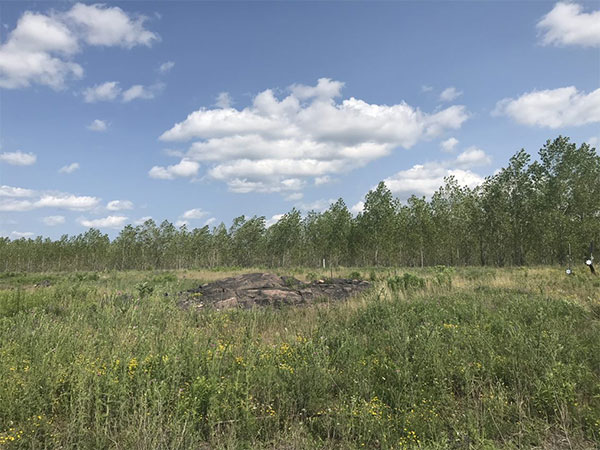
Poplar trees planted on tailings area cover to support a recovering ecosystem
Tailings area
Over 136,140 cubic metres of waste and by-products left over from mining and metal production are safely secured under an 8.5 hectare engineered cover complete with planted poplar trees.
Over 11,000 poplar trees were planted in the tailings area. The trees are working to help absorb water from rain and melted snow and support a restored ecosystem within the site. This cleanup work was completed in 2012.
Industrial and mine area
Approximately 365,865 cubic metres of metal production and industrial waste are safely secured under a multi-layered engineered cover. This cleanup work was completed in 2017.
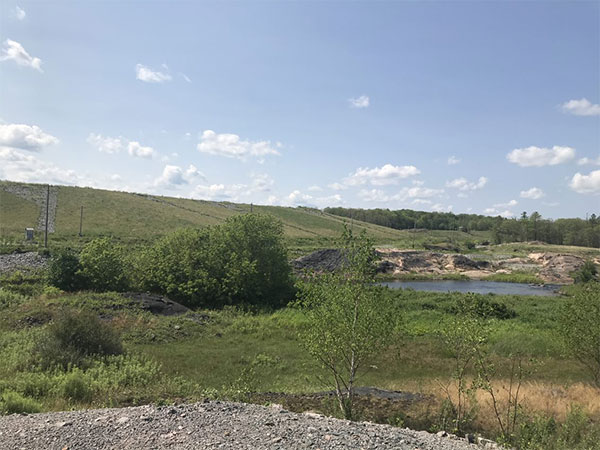
The northern part of the industrial and mine area viewed from the east bank of the Moira River, where historic waste is safely contained.
The cleanup work included planting 250 trees (both basswood and red maple trees) and a variety of native shrubs and grasses throughout the area.
Young’s Creek area
About 110,000 cubic metres of contaminated sediments will be removed and safely secured from this area. Approximately 12,500 cubic metres of the waste is already secured within an on-site engineered containment cell liner. Engineering work is underway to design the safe removal and containment of the remainder of the waste.
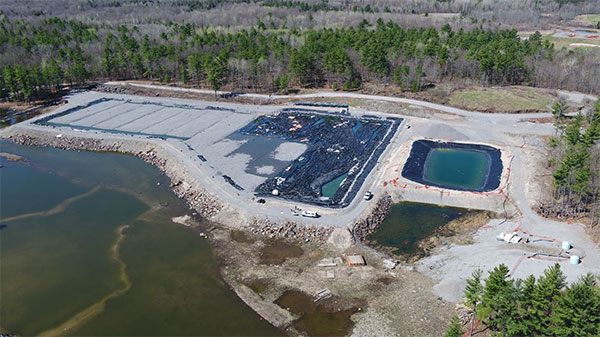
Young's Creek containment cell, showing remediation in progress.
Cleanup work
The Ministry of the Environment, Conservation and Parks is working to mitigate environmental impacts associated with the abandoned Deloro mine and industrial site.
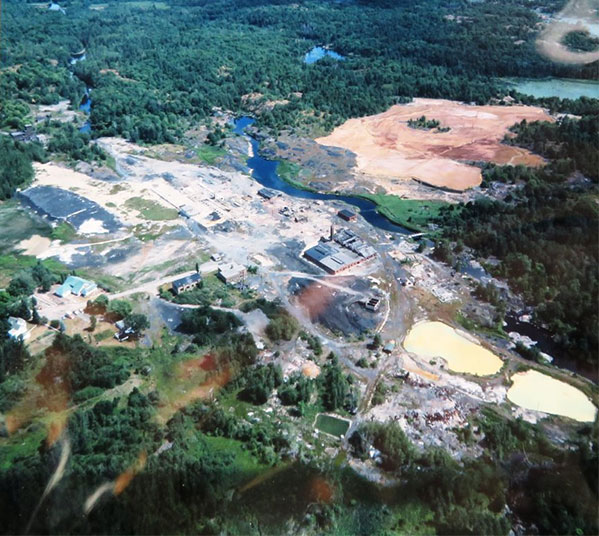
The Deloro site in 1979
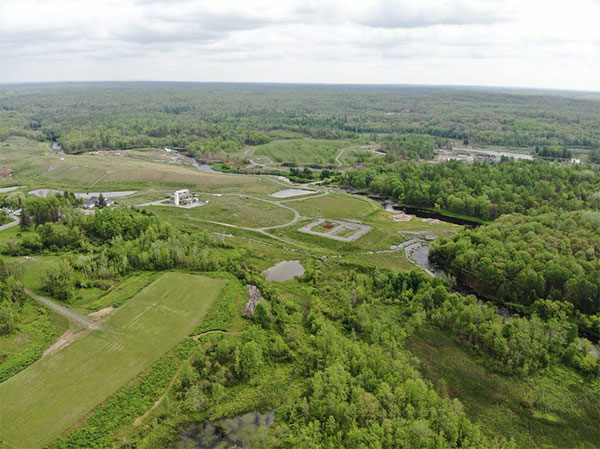
The Deloro site in 2021
The project is containing and securing contaminated waste from the abandoned mine and industrial site to make the area safe for people and the environment. The project is 75% complete and has already significantly improved water quality and the environmental conditions at the site and in the Moira River.
The cleanup work at the Deloro site is an excellent example of the government of Ontario’s commitment to healthier communities and economic prosperity through protecting Ontario’s air, land and water.
Cleanup activities
The cleanup activities of the Deloro site include:
- containing site waste and contaminated material and building two large engineered covers (multi-layer barriers that isolate the waste and prevent water from coming into contact with it) in the industrial and mine area and the tailings area (complete)
- building one engineered containment cell liner (a fully lined disposal area with multiple barriers to isolate and secure the waste for long term storage) in the Young’s Creek area (complete)
- directing rain and melting snow away from the engineered covers to keep water from getting to the contaminated material and spreading it further (ongoing)
- operating an arsenic treatment plant to pump and treat contaminated groundwater and leachate collected throughout the site (ongoing)
Future cleanup works will include the removal and containment of the rest of the waste in the Young’s Creek area.
At the end of the project, the site will continue to be a closed and controlled hazardous waste facility. It will not accept waste from outside the site.
Arsenic treatment plant
The on-site arsenic treatment plant was designed to treat arsenic-contaminated groundwater at the site. The collection, conveyance, treatment and disposal works includes:
- a groundwater/leachate collection and pumping system
- a concrete cut-off containment wall along the Moira River
- a 9,084 cubic meter equalization storage basin (EQ Pond)
- an arsenic treatment and removal system using ferric chloride, lime and polymer flocculants and a primary clarifier
- ferric arsenate sludge settling and drying lagoons
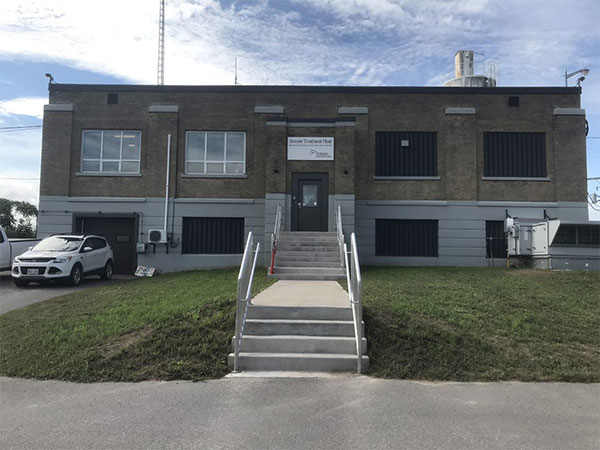
Arsenic treatment plant located at the Deloro site cleanup project. The plant is used to remove arsenic from contaminated water.
The arsenic treatment plant and associated pumping stations and drainage collection systems are operated and maintained by the Ontario Clean Water Agency (OCWA) on behalf of the Ministry of the Environment, Conservation and Parks.
OCWA also performs operational, surface and groundwater sampling programs at the site, including the operation and maintenance of an on-site laboratory to ensure the safe and efficient operation of the site.
How groundwater is treated for arsenic
Contaminated groundwater, leachate and seepage are collected from the industrial and mine area and the tailings area of the site through a system of perforated drainage tiles, pumping wells and gravity and forcemain sewers.
The contaminated water is conveyed and stored within an equalization storage basin (called the EQ Pond) where the wastewater is then pumped and treated through the arsenic removal process.
The arsenic treatment plant removes an average of over 99.5 per cent of arsenic collected from the contaminated groundwater at the site.
Water quality in the Moira River has improved since the start of the cleanup activities at the site and is expected to continue to improve over time. The cleanup activities at the site have reduced the concentrations of arsenic by over 90 per cent.
Local warnings
You should not swim, fish, or drink water from the Young’s Creek off-site area.
The site is highly contaminated with arsenic and metals. Ontario has posted warning signs in the area and notified property owners directly.
Moira River
Location
The Moira River flows through the Deloro site and ultimately flows to Lake Ontario at Belleville.
Water quality
A 1999 study looked at water and sediment quality and the health of fish and other aquatic life.
It found the historical contamination from nearly 100 years of mining and refining at the Deloro site had not greatly affected the aquatic life in a negative way.
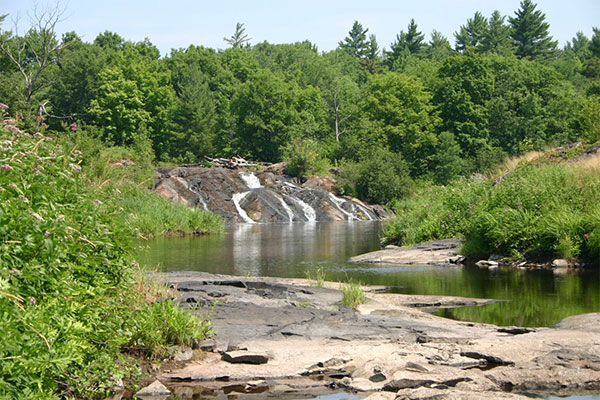
The Deloro Falls on the Moira River located at the Deloro site cleanup project.
Swimming
You are safe to swim anywhere in the Moira River and in Moira and Stoco Lakes — unless you see a notice posted by the local health unit warning about bacteria levels.
Fishing
Most fish in the river system are safe to eat.
You can read about the types and amounts of fish that are safe to eat in the Guide to Eating Ontario Fish.
Drinking water
You should not drink or consume water from the river between the Deloro site and Moira Lake or from the lake itself unless you have a treatment system that can remove arsenic, like a reverse osmosis filtration system. Levels of arsenic in this section of the river are higher than the Ontario Drinking Water Quality Standards.
Ontario and the Hastings and Prince Edward Counties Health Unit issue annual reminders to residents along this section of the river.
Sediment
The sediment throughout the Moira River system contains elevated levels of arsenic and metals, in part because of the historical activities at the Deloro site which included mining, refining and manufacturing.
The Moira River Study (2001) concluded that recreational activities (such as swimming) are safe anywhere in the Moira River and in Moira and Stoco Lakes, unless you see a notice posted by the local health unit warning about bacteria levels or other concerns.
Deloro Village Environmental Health Risk Study
A detailed environmental health risk study was conducted in 1998-99 in the Village of Deloro.
The study tested thousands of samples and looked at potential health risks. It showed the soil had raised levels of arsenic and metals but did not show any health risks to residents.
If you are interested in reviewing these sampling results, please contact the Ministry of the Environment, Conservation and Parks, Eastern Region Office at
Science and engineering work
There are a number of technical and scientific reports related to on-site and off-site studies, including:
- a full Environmental Assessment Study Report
- technical reports used to develop the cleanup plan
- reports related to archaeological and heritage aspects of the site
Public consultations
Ontario consulted with the public on:
- the cleanup plan
- the environmental assessment
- the Moira River Study
- the cultural heritage evaluation of the site
Public Liaison Committee
The Public Liaison Committee meets yearly to share information and receive public input on all aspects of the project.
The committee is made up of:
- Village of Deloro residents
- representatives from local municipalities
- local environmental groups
- local property owners’ associations
- interested individuals
Meetings are open and new members are welcome. If you would like to be a member of the Public Liaison Committee, please contact us.
Construction and on-site work information
Contractors’ hours
7 a.m. – 6 p.m.
Contractors can work until 10 p.m., seven days a week according to the municipality’s noise by-law.
Trucks
Trucks enter through the site’s back entrance from Highway 7. An on-site bridge was upgraded in 2012 to keep heavy truck traffic from going through the Village of Deloro.
Dust control and air monitoring
Dust control measures are in place during any active construction periods. The contractors use a variety of methods to control dust which include the use of water and other dust suppressants on roads and disturbed soil and minimizing work that may disturb soil in periods of high winds.
Environmental monitoring
Ontario monitors surface water and groundwater quality at the site.
Construction contracts
You can see and bid on construction contracts through the government’s electronic tendering service.
Visit the Ontario Tenders Portal website to subscribe to the service or get more information.
Accessing the site
The site is not open for public tours.
You can access a viewing platform just outside the gates, near the Arsenic Treatment Plant, located east of the Deloro Road and O’Brien Street intersection. You can also view interpretive display panels at this location.
Trespassing
Trespassing will increase your risk of being exposed to high levels of contamination on the site. Hazards from construction and historic mining activities also present safety risks.
Trespassers can be prosecuted and fined.
Report suspicious activity
For immediate concerns about suspicious activity at the site after hours or on weekends, contact:
Falcon Security: